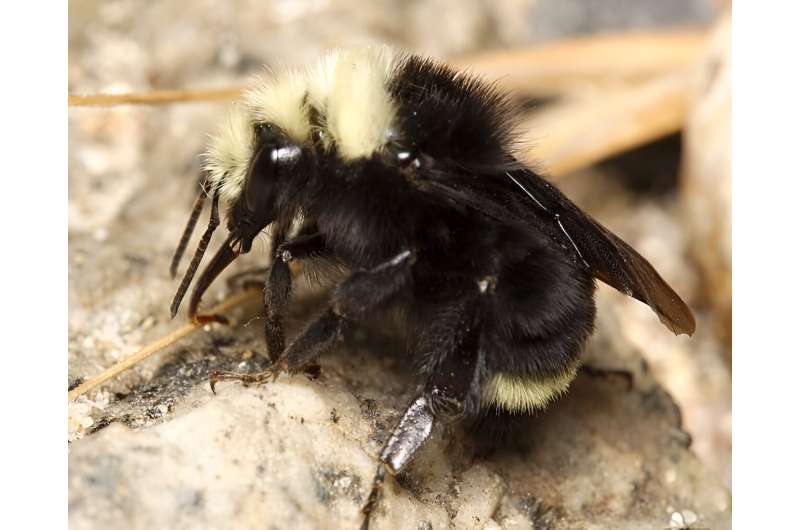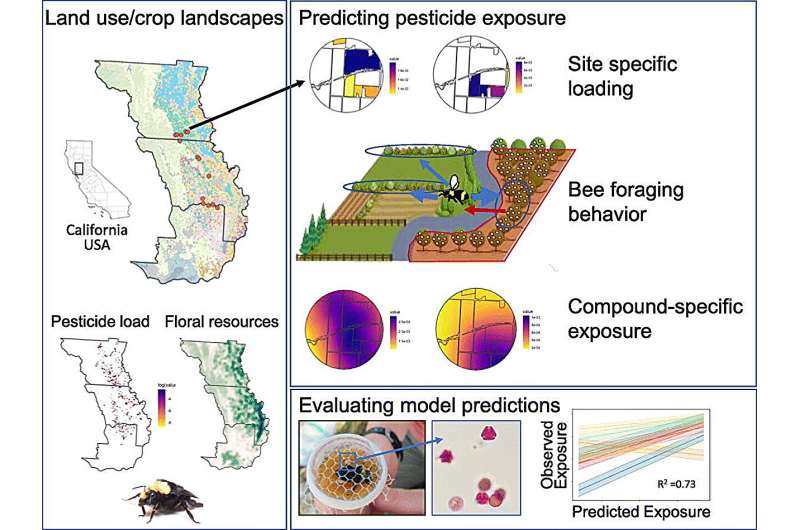This article has been reviewed according to Science X's editorial process and policies. Editors have highlighted the following attributes while ensuring the content's credibility:
fact-checked
peer-reviewed publication
trusted source
proofread
Spatial model predicts bumblebee exposure to pesticide use

It has long been known that agricultural pesticides are one of the greatest threats to bees and other essential pollinators. What farmers have lacked is an understanding of how different pesticides, applied at various times on a variety of crops, affect the risk of exposure to bees living near the fields.
Researchers have drawn from real-world data to try to address this gap, developing and testing a spatial model for predicting pesticide exposure in bumblebees. The work is published in Science of the Total Environment and focuses on the interactions of the yellow-faced bumblebee (Bombus vosnesenskii) with crops in California.
"We were able to explain nearly 75% of the spatial variation in pesticide exposure among the bumblebee hives using our model," says Eric Lonsdorf, first author of the study and assistant professor in Emory's Department of Environmental Sciences.
Relatively simple models were more effective at preventing exposures than the researchers expected.
"Our results suggest that simply data on where and when a pesticide was sprayed is all that you need to make a good prediction for the threat to nearby hives," Lonsdorf says.
Including data on how long a particular chemical lingers in the landscape or how attractive the flowers in a particular crop are to the bees did not make a significant difference in the model's predictive power.
"We found that even if a crop is not that attractive to the bees, the chemicals from that crop are still going to be found in their pollen," Lonsdorf says. "The bees may be picking up the chemical due to drift of the pesticide onto nearby weeds where they are foraging."
Providing tools for conservation
Lonsdorf studies natural capital, or nature's contributions to humans. He translates ecological principles and knowledge into predictive models that enable industry leaders and policymakers to better manage natural resources.
He's currently using models he developed to help the U.S. Fish and Wildlife Service identify bee conservation priority areas in the United States.
More research is needed, Lonsdorf says, to determine whether the bumblebee risk-prediction model will scale up across different landscapes and for different species of bees. The current study also did not delve into how the amount of a particular pesticide found in the pollen translated into toxicity for the bees.

Drawing from fine-scaled data
The researchers began with experiments set amid a variety of crops in northern California's Yolo County. Fourteen pairs of yellow-faced bumblebee colonies were placed around the agricultural landscape. This species of bumblebee is native to the West Coast and the most abundant wild species of bee in this range, found in both urban and agricultural areas.
Pollen that bees in each hive collected were sampled at six different times during the growing season. The pollen samples were then assessed for exposure to 52 different active ingredients encompassing a range of pesticides.
Data from these experiments were combined with field-level data from the California Department of Pesticide Regulation on what pesticides were sprayed and what days they were sprayed.
"California is unique in providing such fine-scaled, public data," Lonsdorf says. "In most places in the United States, information on what pesticides are being sprayed is only collected at the county level and summarized on an annual basis."
The detailed data allowed the researchers to consider a range of factors in their predictive model to identify those factors with the most predictive power.
"Our risk-prediction model marks another step toward evaluating pollinator-conservation issues to help guide policies for pollinator landscapes," Lonsdorf says. "The next step is to do a field toxicity assessment to get a better understanding of how pesticides are affecting bee health."
He and colleagues are now conducting such a study with honeybees, he adds.
More information: Eric V. Lonsdorf et al, A spatially explicit model of landscape pesticide exposure to bees: Development, exploration, and evaluation, Science of The Total Environment (2023). DOI: 10.1016/j.scitotenv.2023.168146
Journal information: Science of the Total Environment
Provided by Emory University




















